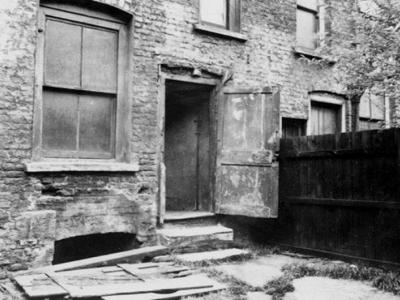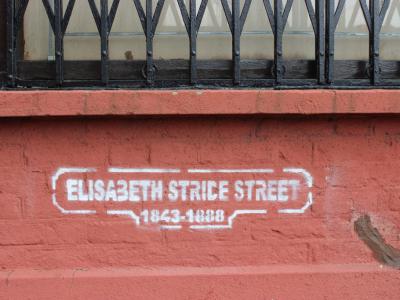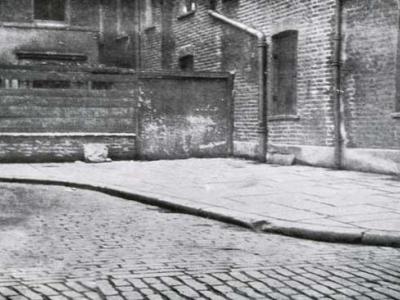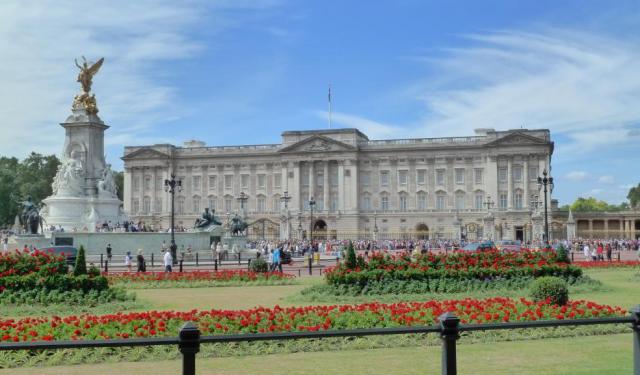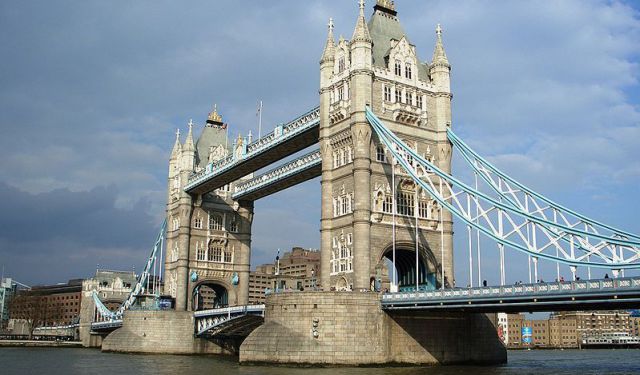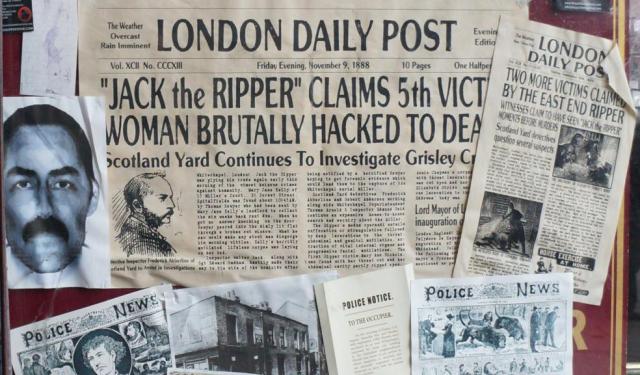
Jack the Ripper Walking Tour (Self Guided), London
Jack the Ripper, an unidentified serial killer who terrorized the British capital in 1888, became notorious for the series of brutal and gruesome murders that he carried out in the East End of London. The primary setting for the Jack the Ripper attacks was Whitechapel, at the time a poverty-stricken and crime-ridden district, known for its dark alleys and narrow streets.
The name "Jack the Ripper" originated from several letters written to the police and local press, supposedly by the killer himself. The Ripper targeted vulnerable women who worked as prostitutes and is believed to be responsible for at least five murders, known as the "canonical five", namely of Mary Ann Nichols, Annie Chapman, Elizabeth Stride, Catherine Eddowes, and Mary Jane Kelly.
His modus operandi typically involved attacking the victims at night, strangling them, and then mutilating their bodies with a sharp knife. Characterized by the extreme violence, the murders were marked by a level of precision and anatomical knowledge, suggesting some degree of surgical skill or knowledge of human anatomy.
Despite an extensive investigation involving the police, the true identity of Jack the Ripper remains unknown to this day. Numerous suspects were considered, including local residents, doctors, and even members of the royal family, but no definitive evidence was ever found to conclusively identify the killer. The nature of the crimes and the sensational media coverage surrounding them fueled public panic and speculation, leaving a lasting impression on the city.
It's worth noting that the cityscape of London has changed significantly over the years. While this is most certainly true with regards to the actual murder sites, all of which have now been obliterated, there are still sections of the East End and locations associated with the case that have changed little since the late 1800s and can be visited today.
The story of Jack the Ripper represents one of the most enduring and haunting mysteries in criminal practice. On this self-guided walk, we invite you to retrace the steps of Jack the Ripper, stopping at key locations such as Durward Street, Gunthorpe Street, Dutfield's Yard, and Mitre Square, where the victims met their end, and get a chilling glimpse into this dark chapter of London's history.
The name "Jack the Ripper" originated from several letters written to the police and local press, supposedly by the killer himself. The Ripper targeted vulnerable women who worked as prostitutes and is believed to be responsible for at least five murders, known as the "canonical five", namely of Mary Ann Nichols, Annie Chapman, Elizabeth Stride, Catherine Eddowes, and Mary Jane Kelly.
His modus operandi typically involved attacking the victims at night, strangling them, and then mutilating their bodies with a sharp knife. Characterized by the extreme violence, the murders were marked by a level of precision and anatomical knowledge, suggesting some degree of surgical skill or knowledge of human anatomy.
Despite an extensive investigation involving the police, the true identity of Jack the Ripper remains unknown to this day. Numerous suspects were considered, including local residents, doctors, and even members of the royal family, but no definitive evidence was ever found to conclusively identify the killer. The nature of the crimes and the sensational media coverage surrounding them fueled public panic and speculation, leaving a lasting impression on the city.
It's worth noting that the cityscape of London has changed significantly over the years. While this is most certainly true with regards to the actual murder sites, all of which have now been obliterated, there are still sections of the East End and locations associated with the case that have changed little since the late 1800s and can be visited today.
The story of Jack the Ripper represents one of the most enduring and haunting mysteries in criminal practice. On this self-guided walk, we invite you to retrace the steps of Jack the Ripper, stopping at key locations such as Durward Street, Gunthorpe Street, Dutfield's Yard, and Mitre Square, where the victims met their end, and get a chilling glimpse into this dark chapter of London's history.
How it works: Download the app "GPSmyCity: Walks in 1K+ Cities" from Apple App Store or Google Play Store to your mobile phone or tablet. The app turns your mobile device into a personal tour guide and its built-in GPS navigation functions guide you from one tour stop to next. The app works offline, so no data plan is needed when traveling abroad.
Jack the Ripper Walking Tour Map
Guide Name: Jack the Ripper Walking Tour
Guide Location: England » London (See other walking tours in London)
Guide Type: Self-guided Walking Tour (Sightseeing)
# of Attractions: 7
Tour Duration: 2 Hour(s)
Travel Distance: 4.0 Km or 2.5 Miles
Author: Xena
Sight(s) Featured in This Guide:
Guide Location: England » London (See other walking tours in London)
Guide Type: Self-guided Walking Tour (Sightseeing)
# of Attractions: 7
Tour Duration: 2 Hour(s)
Travel Distance: 4.0 Km or 2.5 Miles
Author: Xena
Sight(s) Featured in This Guide:
- Durward Street (Mary Nichols Murder Site)
- Royal London Hospital
- Hanbury Street (Annie Chapman's Murder Site)
- Gunthorpe Street (Martha Tabram's Murder Site)
- Dutfield's Yard (Elizabeth Stride's Murder Site)
- Jack the Ripper Museum
- Mitre Square (Catherine Eddowes' Murder Site)
1) Durward Street (Mary Nichols Murder Site)
Durward Street, previously known as Bucks Row, holds significant historical importance in the context of the Whitechapel murders, particularly concerning the first 'official' victim of Jack the Ripper, Mary 'Polly' Nicholls.
During the early hours of August 31, 1888, Polly met a tragic end on Bucks Row. Inebriated and wandering the streets, she was desperately trying to acquire "doss money" to secure shelter for the night. She ultimately fell prey to a brutal assault and was discovered near a school, within a gateway situated in front of one of the residences that once lined this thoroughfare.
Roughly an hour prior to her body being discovered, Mary Nichols was last seen alive by Mrs Emily Holland, a former bedmate at a lodging-house on Thrawl Street, who observed her walking towards Whitechapel Road. Tragically, just minutes later, her throat had been cut by two deep incisions, one of which completely severed the tissue down to the vertebrae. Furthermore, her vagina had been stabbed twice, and a deep, jagged wound had partially torn open the lower part of her abdomen, causing her bowels to protrude. Additionally, the same knife had inflicted several other incisions on both sides of her abdomen, all made in a downward thrusting manner.
In the present day, Durward Street has experienced significant transformations that have diminished its historical importance. The sole surviving relic from 1888 is the former school building, now repurposed as apartments. The surrounding locality has undergone extensive redevelopment, leading to the obliteration of the original street layout and structures. A few remnants from the past, like substantial potholes that reveal fragments of the ancient cobblestones, serve as the sole reminders of the street's former character.
During the early hours of August 31, 1888, Polly met a tragic end on Bucks Row. Inebriated and wandering the streets, she was desperately trying to acquire "doss money" to secure shelter for the night. She ultimately fell prey to a brutal assault and was discovered near a school, within a gateway situated in front of one of the residences that once lined this thoroughfare.
Roughly an hour prior to her body being discovered, Mary Nichols was last seen alive by Mrs Emily Holland, a former bedmate at a lodging-house on Thrawl Street, who observed her walking towards Whitechapel Road. Tragically, just minutes later, her throat had been cut by two deep incisions, one of which completely severed the tissue down to the vertebrae. Furthermore, her vagina had been stabbed twice, and a deep, jagged wound had partially torn open the lower part of her abdomen, causing her bowels to protrude. Additionally, the same knife had inflicted several other incisions on both sides of her abdomen, all made in a downward thrusting manner.
In the present day, Durward Street has experienced significant transformations that have diminished its historical importance. The sole surviving relic from 1888 is the former school building, now repurposed as apartments. The surrounding locality has undergone extensive redevelopment, leading to the obliteration of the original street layout and structures. A few remnants from the past, like substantial potholes that reveal fragments of the ancient cobblestones, serve as the sole reminders of the street's former character.
2) Royal London Hospital
The Royal London Hospital holds an fascinating connection to the infamous Jack the Ripper case, adding an intriguing dimension to its historical significance. While the hospital primarily focuses on providing medical care, it has become intertwined with the captivating events surrounding the Whitechapel Murders in the late 19th century.
In April 1888, a woman named Emma Smith passed away at the hospital. Although her account shortly before her death suggested an attack by a gang rather than being a victim of Jack the Ripper, her name carries importance as the first to appear in the broader Whitechapel Murders records.
Another noteworthy incident involving the hospital occurred in October 1888, when Mr. George Lusk received a kidney along with the infamous 'From Hell' letter. Subsequently, the kidney was sent to the London Hospital for examination by Dr. Thomas Openshaw, the Pathological Curator. The police aimed to determine whether the kidney belonged to Jack the Ripper's fourth victim, Catherine Eddowes, who was murdered on September 30, 1888. Regrettably, Dr. Openshaw could only conclude that the specimen constituted half of a left human kidney, and he was unable to determine its gender or the duration since its removal from the body.
The London Hospital Museum previously hosted an exhibition dedicated to the hospital's connection to the Jack the Ripper case, including a copy of the infamous 'From Hell' letter and other memorabilia associated with the Whitechapel Murders events.
In April 1888, a woman named Emma Smith passed away at the hospital. Although her account shortly before her death suggested an attack by a gang rather than being a victim of Jack the Ripper, her name carries importance as the first to appear in the broader Whitechapel Murders records.
Another noteworthy incident involving the hospital occurred in October 1888, when Mr. George Lusk received a kidney along with the infamous 'From Hell' letter. Subsequently, the kidney was sent to the London Hospital for examination by Dr. Thomas Openshaw, the Pathological Curator. The police aimed to determine whether the kidney belonged to Jack the Ripper's fourth victim, Catherine Eddowes, who was murdered on September 30, 1888. Regrettably, Dr. Openshaw could only conclude that the specimen constituted half of a left human kidney, and he was unable to determine its gender or the duration since its removal from the body.
The London Hospital Museum previously hosted an exhibition dedicated to the hospital's connection to the Jack the Ripper case, including a copy of the infamous 'From Hell' letter and other memorabilia associated with the Whitechapel Murders events.
3) Hanbury Street (Annie Chapman's Murder Site)
In the early hours of Saturday, September 8, 1888, the deceased body of Annie Chapman was found at approximately 6 AM near the stairs that led to the rear yard of 29 Hanbury Street in Spitalfields. Her gruesome murder shocked the community: Chapman's throat had been brutally severed by two deep cuts. Even more disturbing, her abdomen had been completely opened, and parts of her flesh, including a section of her stomach, were placed on her left shoulder. Another section of skin and flesh, along with her small intestines, had been removed and positioned above her right shoulder. The autopsy further revealed the removal of her uterus, sections of her bladder, and parts of her vagina.
During the subsequent inquiry into Chapman's murder, Elizabeth Long provided a crucial testimony. She recounted witnessing Chapman standing outside 29 Hanbury Street at approximately 5:30 AM in the company of a dark-haired man. The man wore a brown deer-stalker hat and a dark overcoat, giving him a "shabby-genteel" appearance. According to Long, the man asked Chapman, "Will you?" and she responded with a simple "Yes." This exchange became a significant piece of evidence.
Hanbury Street, now situated in the vibrant heart of the trendy East End, bears historical significance due to the events that transpired there. It is also noteworthy for its proximity to the Ten Bells pub, where Annie Chapman was reportedly drinking on that fateful day. Chapman lived in Dorset Street, just across from the pub, but lacked the money for lodging. It is speculated that she may have encountered a man at the pub..
The Ten Bells pub itself had a notorious reputation, located adjacent to Itchy Park and serving as a well-known gathering spot. It stood in the heart of the poverty-stricken Spitalfields area, where the slums were at their most dire. However, Hanbury Street has undergone substantial transformations since then. The entire side of the street where number 29 once stood has been demolished and replaced by brewery buildings, effectively erasing the physical traces of that tragic chapter in history.
During the subsequent inquiry into Chapman's murder, Elizabeth Long provided a crucial testimony. She recounted witnessing Chapman standing outside 29 Hanbury Street at approximately 5:30 AM in the company of a dark-haired man. The man wore a brown deer-stalker hat and a dark overcoat, giving him a "shabby-genteel" appearance. According to Long, the man asked Chapman, "Will you?" and she responded with a simple "Yes." This exchange became a significant piece of evidence.
Hanbury Street, now situated in the vibrant heart of the trendy East End, bears historical significance due to the events that transpired there. It is also noteworthy for its proximity to the Ten Bells pub, where Annie Chapman was reportedly drinking on that fateful day. Chapman lived in Dorset Street, just across from the pub, but lacked the money for lodging. It is speculated that she may have encountered a man at the pub..
The Ten Bells pub itself had a notorious reputation, located adjacent to Itchy Park and serving as a well-known gathering spot. It stood in the heart of the poverty-stricken Spitalfields area, where the slums were at their most dire. However, Hanbury Street has undergone substantial transformations since then. The entire side of the street where number 29 once stood has been demolished and replaced by brewery buildings, effectively erasing the physical traces of that tragic chapter in history.
4) Gunthorpe Street (Martha Tabram's Murder Site)
Gunthorpe Street, once called Georges Yard, is a narrow passage in the historic East End of London that captures the essence of the area's dark and historic past. Nestled next to the White Hart pub on Whitechapel High Street, it's a concealed treasure, maintaining much of its atmospheric charm. Accessed through an archway and adorned with cobblestones, it carries whispers of a bygone time.
In their heyday, both the pub and the alley were prominent landmarks at the heart of Whitechapel. This area was notorious, and Gunthorpe Street, together with its adjacent counterpart, Angel Alley, were well-known locations for secret rendezvous. When individuals sought a sheltered spot for their meetings, these alleys became favored hideaways for clandestine encounters.
George's Yard Buildings, a corridor within Gunthorpe Street, gained infamy as the location where Martha Tabram's body was discovered on the morning of August 7, 1888. Although her murder is not officially attributed to Jack the Ripper, it holds a place of significance. Unlike the Ripper's other victims, Martha was stabbed multiple times rather than having her throat slit. Some argue that this difference in 'modus operandi' sets her apart. However, with 39 stab wounds, the timing of the crime, and the brutality of the attack, many firmly believe Martha's murder should be considered the first at the hands of the Ripper.
On that ill-fated day, Martha and her companion, May Ann 'Pearly Poll' Connelly, had a chance encounter with two men at a nearby pub. Opting for different alleyways, Martha chose one path while Pearly ventured down another. Tragically, Martha never reappeared from the alley, forever intertwining her destiny with the eerie legacy of Gunthorpe Street.
Today, as you gaze down Gunthorpe Street towards the entrance of Whitechapel High Road, you can imagine the chilling scene that unfolded at George's Yard Buildings, serving as a reminder of the dark secrets that once permeated this historic alleyway.
In their heyday, both the pub and the alley were prominent landmarks at the heart of Whitechapel. This area was notorious, and Gunthorpe Street, together with its adjacent counterpart, Angel Alley, were well-known locations for secret rendezvous. When individuals sought a sheltered spot for their meetings, these alleys became favored hideaways for clandestine encounters.
George's Yard Buildings, a corridor within Gunthorpe Street, gained infamy as the location where Martha Tabram's body was discovered on the morning of August 7, 1888. Although her murder is not officially attributed to Jack the Ripper, it holds a place of significance. Unlike the Ripper's other victims, Martha was stabbed multiple times rather than having her throat slit. Some argue that this difference in 'modus operandi' sets her apart. However, with 39 stab wounds, the timing of the crime, and the brutality of the attack, many firmly believe Martha's murder should be considered the first at the hands of the Ripper.
On that ill-fated day, Martha and her companion, May Ann 'Pearly Poll' Connelly, had a chance encounter with two men at a nearby pub. Opting for different alleyways, Martha chose one path while Pearly ventured down another. Tragically, Martha never reappeared from the alley, forever intertwining her destiny with the eerie legacy of Gunthorpe Street.
Today, as you gaze down Gunthorpe Street towards the entrance of Whitechapel High Road, you can imagine the chilling scene that unfolded at George's Yard Buildings, serving as a reminder of the dark secrets that once permeated this historic alleyway.
5) Dutfield's Yard (Elizabeth Stride's Murder Site)
Dutfield's Yard, located off Berner Street (now Henriques Street) in Whitechapel, became a chilling crime scene in the early hours of Sunday, September 30, 1888. It was in this location that the life of Elizabeth Stride was tragically brought to an end. Stride's lifeless body was discovered around 1 a.m. within the dimly lit confines of Dutfield's Yard. The cause of her demise was a precise, single incision that spanned six inches across her neck, severing her left carotid artery, trachea, and ending just below her right jaw.
Curiously, in contrast to the other victims of the Ripper, Stride's body showed no additional mutilations. This has given rise to speculation and uncertainty regarding whether her murder was the handiwork of the infamous Ripper or if the assailant was interrupted during the assault. The lack of further bodily harm continues to fuel ongoing discussions and investigations surrounding her murderer's true identity.
In the aftermath of the crime, several witnesses came forward and informed the police that they had seen Stride in the company of a man near or in close proximity to Berner Street on the evening of September 29 and in the early hours of September 30; however, the descriptions provided by these witnesses varied significantly. Some mentioned a fair-haired individual, while others described a dark-haired man. Discrepancies also emerged regarding the man's attire, with some witnesses recalling a poorly dressed companion while others recalled a well-dressed one.
Curiously, in contrast to the other victims of the Ripper, Stride's body showed no additional mutilations. This has given rise to speculation and uncertainty regarding whether her murder was the handiwork of the infamous Ripper or if the assailant was interrupted during the assault. The lack of further bodily harm continues to fuel ongoing discussions and investigations surrounding her murderer's true identity.
In the aftermath of the crime, several witnesses came forward and informed the police that they had seen Stride in the company of a man near or in close proximity to Berner Street on the evening of September 29 and in the early hours of September 30; however, the descriptions provided by these witnesses varied significantly. Some mentioned a fair-haired individual, while others described a dark-haired man. Discrepancies also emerged regarding the man's attire, with some witnesses recalling a poorly dressed companion while others recalled a well-dressed one.
6) Jack the Ripper Museum
Having opened its doors in August 2015, this museum's primary focus revolves around recreating the atmospheric ambiance of London's East End during the notorious and still unsolved Jack the Ripper murders of 1888. Within its walls, visitors can explore a compelling blend of original artifacts from that era and intricate waxwork reconstructions of crime scenes and settings. This captivating blend draws in individuals eager to delve into the chilling history of the infamous serial killer and the evocative backdrop of Victorian-era London.
The museum's establishment is credited to Mark Palmer-Edgecumbe, who had previously served as the head of diversity at Google. Interestingly, the initial planning application referred to it as a "Museum of Women's History"; however, it was later revealed, to the surprise of many, that the focus would be dedicated to the subject of Jack the Ripper, leading to considerable public outcry and protests as the building's facade became visible.
Within the five-room exhibition, visitors can immerse themselves in various recreations of historically significant locations, including a replica of the police station in Leman Street, where detectives tirelessly worked to unmask the elusive murderer. Moreover, there are reenactments of Mary Jane Kelly's bedroom, one of the Ripper's victims, and the scene of Catherine Eddowes' murder, complete with an effigy of police constable Edward Watkins standing vigil over her, as well as the whistle that he used to call for assistance.
Descending into the basement, visitors will find a simulated morgue housing memorials dedicated to the "canonical five" victims: Mary Ann Nichols, Annie Chapman, Elizabeth Stride, Catherine Eddowes, and Mary Jane Kelly. Additional tributes are paid to Emma Elizabeth Smith, Alice McKenzie, and Frances Coles, other women connected to the Ripper case.
Why You Should Visit:
Despite its contentious beginnings, the museum offers a one-of-a-kind experience that melds historical relics, intricate reconstructions, and a solemn contemplation of the victims' lives and the enduring mystery surrounding these crimes.
The museum's establishment is credited to Mark Palmer-Edgecumbe, who had previously served as the head of diversity at Google. Interestingly, the initial planning application referred to it as a "Museum of Women's History"; however, it was later revealed, to the surprise of many, that the focus would be dedicated to the subject of Jack the Ripper, leading to considerable public outcry and protests as the building's facade became visible.
Within the five-room exhibition, visitors can immerse themselves in various recreations of historically significant locations, including a replica of the police station in Leman Street, where detectives tirelessly worked to unmask the elusive murderer. Moreover, there are reenactments of Mary Jane Kelly's bedroom, one of the Ripper's victims, and the scene of Catherine Eddowes' murder, complete with an effigy of police constable Edward Watkins standing vigil over her, as well as the whistle that he used to call for assistance.
Descending into the basement, visitors will find a simulated morgue housing memorials dedicated to the "canonical five" victims: Mary Ann Nichols, Annie Chapman, Elizabeth Stride, Catherine Eddowes, and Mary Jane Kelly. Additional tributes are paid to Emma Elizabeth Smith, Alice McKenzie, and Frances Coles, other women connected to the Ripper case.
Why You Should Visit:
Despite its contentious beginnings, the museum offers a one-of-a-kind experience that melds historical relics, intricate reconstructions, and a solemn contemplation of the victims' lives and the enduring mystery surrounding these crimes.
7) Mitre Square (Catherine Eddowes' Murder Site)
Mitre Square, situated within the City of London, became a somber location deeply intertwined with the infamous Jack the Ripper case. It was here that Catherine Eddowes's lifeless body was discovered, just three-quarters of an hour after that of Elizabeth Stride was found in close proximity. The scene was nothing short of horrifying, as Eddowes bore the marks of savage brutality. Her throat had been viciously slashed from ear to ear, and her abdomen had been gruesomely torn open by a deep, jagged wound. Adding to the macabre tableau, her intestines had been placed over her right shoulder, and a detached section of intestine was positioned between her body and left arm.
The mutilations inficted upon Eddowes extended beyond her abdomen, as her left kidney and a significant portion of her uterus had been removed. Her face bore disfigurement, as her nose had been severed, her cheek slashed, and incisions measuring a quarter and half an inch vertically marked each of her eyelids; additionally, triangular incisions pointing towards her eyes were carved on each of her cheeks. Thorough examinations of her clothing later revealed that a section of her right ear's auricle and lobe had been severed as well. The police surgeon estimated that these gruesome mutilations would have taken at least five minutes to carry out.
Joseph Lawende, a local cigarette vendor, had traversed the square alongside two companions shortly before the homicide occurred. He recalled seeing a disheveled fair-haired man with a woman who might have been Eddowes. Regrettably, Lawende's associates couldn't corroborate his description. This dual occurrence, involving the murders of Stride and Eddowes, became known as the "double event".
A perplexing twist unfolded when a stained fragment of Eddowes's apron was found at the entrance to a Whitechapel tenement on Goulston Street at 2:55 a.m. Above the apron lay a chilling chalk inscription: "The Juwes are The men That Will not be Blamed for nothing". This message appeared to imply potential Jewish involvement in the crimes, although it remains uncertain whether the graffiti was left by the perpetrator or had no connection to the case. Such graffiti was not an uncommon sight in Whitechapel. To mitigate potential anti-Semitic tensions, Police Commissioner Charles Warren ordered the removal of the writing before daybreak.
The mutilations inficted upon Eddowes extended beyond her abdomen, as her left kidney and a significant portion of her uterus had been removed. Her face bore disfigurement, as her nose had been severed, her cheek slashed, and incisions measuring a quarter and half an inch vertically marked each of her eyelids; additionally, triangular incisions pointing towards her eyes were carved on each of her cheeks. Thorough examinations of her clothing later revealed that a section of her right ear's auricle and lobe had been severed as well. The police surgeon estimated that these gruesome mutilations would have taken at least five minutes to carry out.
Joseph Lawende, a local cigarette vendor, had traversed the square alongside two companions shortly before the homicide occurred. He recalled seeing a disheveled fair-haired man with a woman who might have been Eddowes. Regrettably, Lawende's associates couldn't corroborate his description. This dual occurrence, involving the murders of Stride and Eddowes, became known as the "double event".
A perplexing twist unfolded when a stained fragment of Eddowes's apron was found at the entrance to a Whitechapel tenement on Goulston Street at 2:55 a.m. Above the apron lay a chilling chalk inscription: "The Juwes are The men That Will not be Blamed for nothing". This message appeared to imply potential Jewish involvement in the crimes, although it remains uncertain whether the graffiti was left by the perpetrator or had no connection to the case. Such graffiti was not an uncommon sight in Whitechapel. To mitigate potential anti-Semitic tensions, Police Commissioner Charles Warren ordered the removal of the writing before daybreak.
Walking Tours in London, England
Create Your Own Walk in London
Creating your own self-guided walk in London is easy and fun. Choose the city attractions that you want to see and a walk route map will be created just for you. You can even set your hotel as the start point of the walk.
Walk around Buckingham Palace
Buckingham Palace, the British monarch's official residence, is a must-see for anyone visiting London, but so are the adjacent royal establishments that give a unique window into the royal way of life. On this self-guided walking tour, along with Buckingham Palace and its memorable fountain, you will visit the St. James's private royal residence, the wonderful Queen's Gallery, and... view more
Tour Duration: 1 Hour(s)
Travel Distance: 2.3 Km or 1.4 Miles
Tour Duration: 1 Hour(s)
Travel Distance: 2.3 Km or 1.4 Miles
London's Historic Pubs Walk
If there’s any more iconic symbol for London than Big Ben or the London Eye, then it must be the traditional English pub. And London sure is full of them, dating from pre-Victorian times to just about five minutes ago.
With so much history surrounding London there is no shortage of historic pubs to choose from. Whether you fancy half-timbered, rambling watering holes or small but perfectly... view more
Tour Duration: 3 Hour(s)
Travel Distance: 5.6 Km or 3.5 Miles
With so much history surrounding London there is no shortage of historic pubs to choose from. Whether you fancy half-timbered, rambling watering holes or small but perfectly... view more
Tour Duration: 3 Hour(s)
Travel Distance: 5.6 Km or 3.5 Miles
City of London Walking Tour
The City of London, widely referred to simply as the City (with the capital C), is also colloquially known as the Square Mile, for being just 1.12 sq mi in area. Situated on top of the original Roman center of commerce, called Londinium, established in 43 AD, this neighborhood is the historic and financial heart of the British capital. It has been a major meeting point for international business... view more
Tour Duration: 3 Hour(s)
Travel Distance: 4.6 Km or 2.9 Miles
Tour Duration: 3 Hour(s)
Travel Distance: 4.6 Km or 2.9 Miles
Beatles London Walking Tour
Perhaps one of the most famed and influential bands of all time, whose music has transcended generations, The Beatles continues to be a source of entertainment many decades after the group was formed (1960) and split up (1970).
"The Fab Four" – John Lennon, Paul McCartney, George Harrison and Ringo Starr – all came from Liverpool, but London was indeed their home-base. As the... view more
Tour Duration: 3 Hour(s)
Travel Distance: 4.8 Km or 3 Miles
"The Fab Four" – John Lennon, Paul McCartney, George Harrison and Ringo Starr – all came from Liverpool, but London was indeed their home-base. As the... view more
Tour Duration: 3 Hour(s)
Travel Distance: 4.8 Km or 3 Miles
London Introduction Walking Tour
After the Roman invasion of 43 AD, the settlement of Londinium came into being. Things went well enough until 61 AD. Then Queen Boudica and her Iceni warriors arrived. They burned the town to ashes. They were not just rowdy tourists. Londinium had died but it rose again and it flourished until the Romans left in the 5th century.
With the Romans gone, Londinium was Anglo-Saxon Lundenwic. Until... view more
Tour Duration: 2 Hour(s)
Travel Distance: 4.2 Km or 2.6 Miles
With the Romans gone, Londinium was Anglo-Saxon Lundenwic. Until... view more
Tour Duration: 2 Hour(s)
Travel Distance: 4.2 Km or 2.6 Miles
Sherlock Holmes Tour in London
Among a myriad of other, real-life celebrities who have ever called London their home, perhaps the most famous is the fictional consulting detective, Sherlock Holmes, created by Conan Doyle. Indeed, the ingenious sleuth has left an indelible mark on the literary and cultural landscape of London ever since the appearance of the first stories about him in the late 1880s. Years on, there are several... view more
Tour Duration: 1 Hour(s)
Travel Distance: 2.3 Km or 1.4 Miles
Tour Duration: 1 Hour(s)
Travel Distance: 2.3 Km or 1.4 Miles
Useful Travel Guides for Planning Your Trip
London Souvenirs: 20 Distinctively British Products for Travelers
Most visitors to London consider shopping as part of their must-do London experience. From street markets to Victorian arcades to snobbish Sloane Square to busy Oxford Street, there are a host of shops selling items which typically represent this vibrant city. Whether you are shopping for souvenirs...
The Most Popular Cities
/ view all


